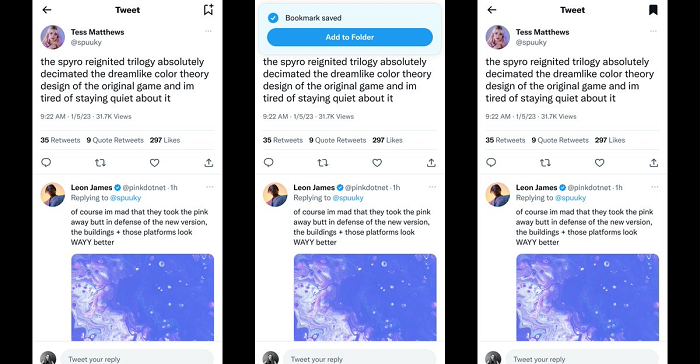SOCIAL
Twitter Previews New Bookmarks UI, Making the Functionality Easier to Access

Twitter sure seems to have a lot of updates and tweaks coming over the next few weeks – at least according to Elon Musk’s tweets.
One of Musk’s new favorite Twitter functions, which he just seems to have discovered, is bookmarks, and using bookmarks as a means to tag a tweet that you may be interested in, but don’t necessarily want to ‘Like’.
Twitter has a bookmark function accessible through share button on tweet.
To read bookmarks, tap profile icon.
This obscure UI will be fixed in Jan.
— Elon Musk (@elonmusk) December 31, 2022
Because ‘Like’ is not always the right flag – I might, for example, want to tag a tweet from Elon himself for an article at a later stage, but maybe I don’t ‘Like’ it, as such. Bookmarks are private, and you can tag anything for later reference – but as Elon says, maybe the functionality is too hidden, reducing its usage.
With this in mind, Twitter’s developing a new approach to the bookmarks display, which would bring the functionality upfront.
As you can see here, in the top right of the tweet detail display, you may soon have a new bookmark option, making it easier to quickly tag and save a tweet for later reading.
Which is good, I guess, and it could help to get more people bookmarking more things.
Will that have any real impact on tweet engagement? Probably not, but Elon seems to be of the belief that bookmarks – like Community Notes and verification ticks – are actually far more valuable than you or I realize.
Though I would argue that most active Twitter users are aware of the bookmarks function, or they have their own process for flagging tweets. Still, maybe it’s an underused option, and maybe, by making it more present, that will indeed get more people bookmarking more things, and deepen their engagement in the app.
And if it doesn’t, and people don’t use it, no real impact, other than development workload on Twitter’s end.
Elon also seems to have broader plans for the use of bookmarks, and what they might mean, in terms of tweet metrics.
Public likes & non-public likes (aka bookmarks) should both be included in like count.
Bookmark button should be on main tweet view.
— Elon Musk (@elonmusk) January 5, 2023
I mean, that probably runs counter to the whole point of adding bookmarks on the main tweet, as an alternative to Likes. But maybe it’s just that they’re private that’s the true value, and incorporating bookmark stats into Likes actually makes some sense.
Overall, I doubt any change to the presentation or measurement of bookmarks will have any major impact on Twitter engagement, but it could be a helpful option to have more immediately available in the UI, and that could get more people gleaning more value from their tweet experience.
And it could also serve as a handy tool for advertisers, especially if Twitter looks to push into shopping, with product listings within tweets. Maybe, by making it easier to save items to a private list, that could also have implications for future product engagement in the app.
As noted, this is just one of several feature updates that Musk has committed to rolling out this month.
As per Elon’s tweets, throughout January, Twitter will be adding:
- The option to side-swipe between algorithmic and real-time tweet feed
- New explanations as to why an account has been suspended
- Updated view count display
- Bookmarks added to main UI
Elon’s looking to boost the rate of implementation, as part of his ‘hardcore’ engineering approach – but thus far, as we’ve seen with Twitter Blue and other tweaks and changes, that rapid deployment approach hasn’t always worked out the best.
But this, apparently, is Elon’s way, and when you spend $44 billion on an app, you get to run it how you want.
It’ll be interesting to see how each of these changes impacts Twitter usage, and whether, cumulatively, they help to shift the needle on its key metrics.
SOCIAL
Snapchat Explores New Messaging Retention Feature: A Game-Changer or Risky Move?

In a recent announcement, Snapchat revealed a groundbreaking update that challenges its traditional design ethos. The platform is experimenting with an option that allows users to defy the 24-hour auto-delete rule, a feature synonymous with Snapchat’s ephemeral messaging model.
The proposed change aims to introduce a “Never delete” option in messaging retention settings, aligning Snapchat more closely with conventional messaging apps. While this move may blur Snapchat’s distinctive selling point, Snap appears convinced of its necessity.
According to Snap, the decision stems from user feedback and a commitment to innovation based on user needs. The company aims to provide greater flexibility and control over conversations, catering to the preferences of its community.
Currently undergoing trials in select markets, the new feature empowers users to adjust retention settings on a conversation-by-conversation basis. Flexibility remains paramount, with participants able to modify settings within chats and receive in-chat notifications to ensure transparency.
Snapchat underscores that the default auto-delete feature will persist, reinforcing its design philosophy centered on ephemerality. However, with the app gaining traction as a primary messaging platform, the option offers users a means to preserve longer chat histories.
The update marks a pivotal moment for Snapchat, renowned for its disappearing message premise, especially popular among younger demographics. Retaining this focus has been pivotal to Snapchat’s identity, but the shift suggests a broader strategy aimed at diversifying its user base.
This strategy may appeal particularly to older demographics, potentially extending Snapchat’s relevance as users age. By emulating features of conventional messaging platforms, Snapchat seeks to enhance its appeal and broaden its reach.
Yet, the introduction of message retention poses questions about Snapchat’s uniqueness. While addressing user demands, the risk of diluting Snapchat’s distinctiveness looms large.
As Snapchat ventures into uncharted territory, the outcome of this experiment remains uncertain. Will message retention propel Snapchat to new heights, or will it compromise the platform’s uniqueness?
Only time will tell.
SOCIAL
Catering to specific audience boosts your business, says accountant turned coach

While it is tempting to try to appeal to a broad audience, the founder of alcohol-free coaching service Just the Tonic, Sandra Parker, believes the best thing you can do for your business is focus on your niche. Here’s how she did just that.
When running a business, reaching out to as many clients as possible can be tempting. But it also risks making your marketing “too generic,” warns Sandra Parker, the founder of Just The Tonic Coaching.
“From the very start of my business, I knew exactly who I could help and who I couldn’t,” Parker told My Biggest Lessons.
Parker struggled with alcohol dependence as a young professional. Today, her business targets high-achieving individuals who face challenges similar to those she had early in her career.
“I understand their frustrations, I understand their fears, and I understand their coping mechanisms and the stories they’re telling themselves,” Parker said. “Because of that, I’m able to market very effectively, to speak in a language that they understand, and am able to reach them.”Â
“I believe that it’s really important that you know exactly who your customer or your client is, and you target them, and you resist the temptation to make your marketing too generic to try and reach everyone,” she explained.
“If you speak specifically to your target clients, you will reach them, and I believe that’s the way that you’re going to be more successful.
Watch the video for more of Sandra Parker’s biggest lessons.
SOCIAL
Instagram Tests Live-Stream Games to Enhance Engagement

Instagram’s testing out some new options to help spice up your live-streams in the app, with some live broadcasters now able to select a game that they can play with viewers in-stream.
As you can see in these example screens, posted by Ahmed Ghanem, some creators now have the option to play either “This or That”, a question and answer prompt that you can share with your viewers, or “Trivia”, to generate more engagement within your IG live-streams.
That could be a simple way to spark more conversation and interaction, which could then lead into further engagement opportunities from your live audience.
Meta’s been exploring more ways to make live-streaming a bigger consideration for IG creators, with a view to live-streams potentially catching on with more users.
That includes the gradual expansion of its “Stars” live-stream donation program, giving more creators in more regions a means to accept donations from live-stream viewers, while back in December, Instagram also added some new options to make it easier to go live using third-party tools via desktop PCs.
Live streaming has been a major shift in China, where shopping live-streams, in particular, have led to massive opportunities for streaming platforms. They haven’t caught on in the same way in Western regions, but as TikTok and YouTube look to push live-stream adoption, there is still a chance that they will become a much bigger element in future.
Which is why IG is also trying to stay in touch, and add more ways for its creators to engage via streams. Live-stream games is another element within this, which could make this a better community-building, and potentially sales-driving option.
We’ve asked Instagram for more information on this test, and we’ll update this post if/when we hear back.
-

 PPC6 days ago
PPC6 days agoHow the TikTok Algorithm Works in 2024 (+9 Ways to Go Viral)
-

 SEO7 days ago
SEO7 days agoBlog Post Checklist: Check All Prior to Hitting “Publish”
-

 SEO5 days ago
SEO5 days agoHow to Use Keywords for SEO: The Complete Beginner’s Guide
-

 MARKETING6 days ago
MARKETING6 days agoHow To Protect Your People and Brand
-

 SEARCHENGINES7 days ago
SEARCHENGINES7 days agoGoogle Started Enforcing The Site Reputation Abuse Policy
-

 PPC7 days ago
PPC7 days agoHow to Craft Compelling Google Ads for eCommerce
-

 MARKETING6 days ago
MARKETING6 days agoElevating Women in SEO for a More Inclusive Industry
-

 PPC6 days ago
PPC6 days agoHow to Brainstorm Business Ideas: 9 Fool-Proof Approaches
















You must be logged in to post a comment Login